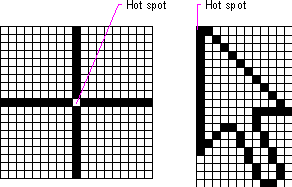
For more information about some of the common pointers, see Chapter 4, "Input Basics." For information about displaying pointers for drag and drop operations, see Chapter 5, "General Interaction Techniques."
You can use a pointer's design to help the user identify objects and provide feedback about certain conditions or states. However, use pointer changes conservatively so that the user is not distracted by excessive flashing of multiple pointer changes while traversing the screen. One way to handle this is to use a time-out before making noncritical pointer changes.
Note 
For more information about some of the common pointers, see Chapter 4, "Input Basics." For information about displaying pointers for drag and drop operations, see Chapter 5, "General Interaction Techniques."
When you use a pointer to provide feedback, use it only over areas where that state applies. For example, when using the hourglass pointer to indicate that a window is temporarily noninteractive, if the pointer moves over a window that is interactive, change it to its appropriate interactive image. If a process makes the entire interface non-interactive, display the hourglass pointer wherever the user moves the pointer.
Pointer feedback may not always be sufficient. For example, for processes that last longer than a few seconds, it is better to use a progress indicator that indicates progressive status, elapsed time, estimated completion time, or some combination of these to provide more information about the state of the operation. In other situations, you can use command button states to reinforce feedback; for example, when the user chooses a drawing tool.
Use a pointer that best fits the context of the activity. The I-beam pointer is best used to select text. The normal arrow pointer works best for most drag and drop operations, modified when appropriate to indicate copy and link operations.
The location for the hot spot of a pointer (shown in Figure 13.29) is important for helping the user target an object. The pointer's design should make the location of the hot spot intuitive. For example, for a cross-hair pointer, the implied hot spot is the intersection of the lines.

Figure 13.29 Pointer hot spots
Animating a pointer can be a very effective way of communicating information. However, remember that the goal is to provide feedback, not to distract the user. In addition, pointer animation should not restrict the user's ability to interact with the interface.